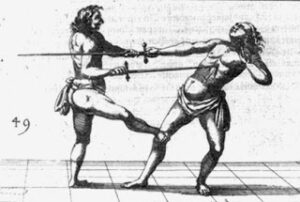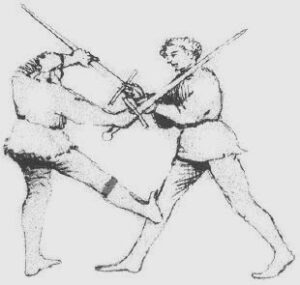
Some olden fencing masters called it “Commanding the blade”. This was the action of grabbing a sword blade to control it. In a recent blog I mentioned that rapier and smallsword blades were not particularly sharp. The need for a rigid, light thrusting blade precluded a blade shape that allowed a very sharp cutting edge. Such blades were sharpened enough to facilitate penetration and deter the blade being grabbed. We know that some blades had some edge since there are accounts of duels being halted due to cuts to the hands.

The wearing of gloves was quite common in duels. A gauntlet cuff prevented a point entering down the swordsman’s sleeve. Naturally enough the free hand was also gloved and some styles of swordplay would use the free hand defensively (”battre de main”). A leather glove would provide ample protection against the modest edge of a rapier or smallsword. Specially designed grasping gloves (guanto di presa) are known to have been used and included such features as palms covered in chainmail or backward facing scales that a tip could not get under. Contemporary instructors tell us that even a bare hand could safely grasp a blade, providing it was gripped securely so that no cutting action could be made.

If we look back to Medieval instruction manuals we see that gripping the blade did not start with rapiers. Cut and thrust broadswords are often shown with the blade being gripped. As well as being held by an adversary the blade was also gripped by the user to execute the “Murderstroke” which involved hammering an enemy with the hilt and guard. Illustrations also show blades being grabbed so the sword can be used two-handed like a rifle with bayonet. (Both are shown in the illustration below). Blades likely to be used against metal armour were not generally sharpened to a fine edge, since it would rapidly become blunted or damaged. Hence such blades could be gripped with reasonable safety.

Most modern assailants would not think of grabbing a blade and I’d not recommend it. Blunt weapons such as batons, staffs and umbrellas stand a good chance of a grab being attempted. Recent discussions on this blog have been about umbrellas so I will continue that thread, although the techniques that will be discussed apply to other weapons too.
1) Weapon grabbed at the end by either one or both hands. If not already doing so, grab the umbrella with both hands. Breaking such a grip used the counters to wrist grabs detailed in my book, so I will not go into great detail here. Basically you apply force against the attacker’s thumb or go under and to the outside of his hand. The length of the umbrella and your two handed grip allows you to apply considerable force.
2) Umbrella grabbed in the middle with one hand. If not already done, grab the umbrella with both hands so his hand is between yours. Rotate the umbrella inwards like it was a sailing ship’s wheel. This motion will take you onto the attacker’s outside gate, avoiding any attack he was attempting with this free hand. The motion should break his grip or pull him off balance. If you block his advance with your inner leg this can be turned into a throwing action. From his side you may be able to strike him using the butt or point.
3) Umbrella grabbed in the middle with both hands. The counter for this is the same as given for the single handed grab to the middle. If the attacker is using both hands to grab your umbrella he cannot use them to defend himself so another option is to step in and use a hand to smash your palm into his nose or chin. If less force is warranted use “Eagle’s Alien” as described in the book. If more force is needed follow the palm strike with a face rake.
4) Umbrella grabbed two-handed with one or both hands outside yours. This is difficult since potentially the attacker has equal or greater leverage, so it is important to gain the initiative by acting rapidly. Rotate your umbrella inwards as described already. If you encounter too much resistance release your upper hand and hammer strike his face or head. Another technique is to step your nearer leg across the front of both of his. If your right is nearer step it over to the outside of his right foot. Sitting down with on your rear heel will apply all of your weight to the umbrella and pull him forward. Your leg prevents him stepping forward so if he keeps his grip he will be pitched forward head first. If he releases the umbrella when you descend ram one end up into his groin or solar plexus. Or hug his legs with both your arms and roll away to bring him down.
Part One Fencing Parries with an Umbrella.
Part One and a bit An Interlude.
Part Two Swagger Stick Techniques.
Part Four Offensive Techniques.